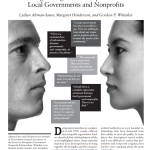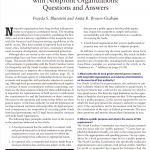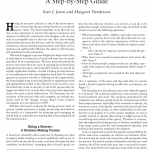Topic: Public Sector Relationships

Working with Nonprofit Organizations
Facing the challenges of providing more and better services while being constrained by difficult fiscal limits, local governments across the United States have increased their involvement with nonprofit organizations, involving nonprofits in service delivery and drawing on these organizations’ volunteers and private financial resources. Some nonprofits have also become skilled advocates for their local government clients, making persuasive appeals for public funding of their work or otherwise helping shape government priorities.
This guidebook focuses primarily on the basic questions North Carolina local governments should ask themselves when deciding whether and how to fund nonprofits. If a governing board is considering an ongoing partnership with a nonprofit, many of these same considerations will apply.
Part of the Local Government Board Builders series, this book was written for elected officials of municipal and county governments, but governing officials of other kinds of public entities, such as councils of government, might also find the information useful.
Cite as:
Henderson, M., Altman, L., Julian, S., Whitaker, G. and Youens, E. (2010). Working with nonprofit organizations. [Chapel Hill, N.C.]: UNC School of Government.
…
Continued
Strengthening Relationships between Local Governments and Nonprofits
This article is based on interviews with more than forty government and nonprofit organization staff members
in seven counties in central North Carolina. Human services agencies were targeted because North Carolina county governments are most likely to fund nonprofits in that area of service. (For a further discussion of counties’ relationships with nonprofits, see the article on page 25.) The two largest counties, Wake and Mecklenburg, were excluded from the study as atypical. The remaining ninety-eight counties were categorized as small, medium, and large on the basis of population, and counties from each category were chosen for study. The study’s geographic reach was limited initially by budgetary constraints and later by the traumatic impact of Hurricane Floyd on eastern North Carolina—no counties from the far western or far eastern areas of the state were included. However, the seven counties in the study included both urban and rural areas that represented a diversity of cultural and political traditions. During the study we asked local government and nonprofit organization staff to assess the nature of their work with each other—how they interacted, what worked well in their relationships, and what factors limited their relationships. We also asked them to describe the differences in decision-making or operational style and the ways in which those differences affected working relationships. Finally, we asked about specific changes that local government and nonprofit organization staff would like to see in relationships or in the way in which services were delivered in their counties. In every community where we interviewed, respondents candidly shared their views. The study was part of a larger project (supported by a grant from the Jessie Ball duPont Fund) to identify and create ways to help nonprofit organizations and government agencies work together to serve the public more effectively.
Cite as:
Altman-Sauer, L., Henderson, M., P. Whitaker, G., (2001) “Strengthening Relationships between Local Governments and Nonprofits”
…
Continued
Local Government Contracts with Nonprofit Organizations: Questions and Answers
Nonprofit organizations have long worked with governments to respond to community needs. The resulting
partnerships have been powerful, combining the flexibility and service-delivery capabilities of the nonprofit sector
with the financial and direction-setting capabilities of the public sector. They have resulted in improved local services in
many areas, including human services, community development, economic development, and environmental protection. Although they are touted as the wave of the future, these partnerships have not been without their fair share of challenges. This article follows other recent efforts by the Institute of Government, in partnership with the North Carolina Center for Nonprofits and the North Carolina Association of County Commissioners, to improve the relationships between local governments and nonprofits (see the sidebar, page 33). It focuses on the legal aspects of relationships between local governments and nonprofits, with particular attention to contracting. Although local governments and nonprofits work together or interact in many circumstances without contracting, contracts are the most common vehicles for these collaborations. It is important for representatives of both sectors to understand
the requirements for and the limitations on these contracts.
Cite as:
Bluestein, Frayda S. and Anita R. Brown-Graham. “Local Government Contracts with Nonprofit Organizations: Questions and Answers.” Popular Government 67:1 (2001): 32-44.
…
Continued
Hiring a Director for a Nonprofit Agency: A Step-by-Step Guide
Hiring an executive director is one of the most important actions that the governing board of a nonprofit
agency takes. The board depends on its director for day-to-day operation to achieve the agency’s purposes and objectives within the constraints of its budget—not an easy task to accomplish year in and year out. Also, the working relationship between the director and the board, the staff, volunteers, clients, funding organizations, and other service agencies can significantly influence the agency’s effectiveness and reputation in the community. This article suggests a process designed to help ensure that, in selecting its next director, a board will meet its own needs and those of its constituencies. We have used and refined the process over more than ten years of assisting local elected and appointed government and nonprofit boards. It should be equally applicable whether a board is hiring its first director or it is replacing one who has resigned or been fired. If a clearly agreed on successor already is working for the organization, the board might want to proceed directly to negotiations with and appointment of him or her. However, even in such a case, the board may want to use part or all of the process that we suggest in order to be certain that it has given this important choice the most careful deliberation. To illuminate our description of the process with real examples, we include materials used in the Orange County Rape Crisis Center’s recruitment of a new director in 1999. Whether the board conducts the hiring process itself or secures outside assistance, it might use the steps described in
this article as a framework for planning and arranging its search and as a checklist for ensuring that it has completed all
the essential tasks.
Cite as:
“Hiring a Director for a Small Community-Based Nonprofit Agency: A Step-by-Step Guide,” by Margaret F. Henderson and Kurt Jenne, Summer 2000, Popular Government.
…
Continued
Evolution of a Nonprofit, Part 2: Shifting Orientation from One Person to the Community
A leader-dominated organization is primarily driven by the efforts and the resources of one person, often the executive director. In contrast, a community-based organization achieves strength through diversification. No single person or funding source drives the work of the organization or controls information flow through it. Part 1 of this article provides a guide for the staff and the board members of nonprofit organizations to assess whether they are shifting or want to shift from being a leader-dominated organization to being a community-based organization.2 The purpose of this part is to propose a step-by-step process for organizations to use as they begin either to discuss such a shift or to make it.
Cite as:
Henderson, Margaret. “Evolution of a Nonprofit, Part 2: Shifting Orientation from One Person to the Community.” Popular Government 70:1 (2004): 1-6.
…
Continued
Evolution of a Nonprofit, Part 1: Determining the Organization’s Orientation
This article describes a series of characteristics that indicate when a nonprofit
might be more accountable to and controlled by one person than it is to the community that it was created to serve.
It is the first part of a two-part article. Part 2 suggests a process that nonprofits might use to evaluate whether they have the interest and the capacity to shift from being a leader-dominated organization to being a community-based organization. Part 2 is available online at www.sog.unc.edu/popgov/.
Cite as:
Henderson, Margaret. “Evolution of a Nonprofit, Part 1: Determining the Organization’s Orientation.” Popular Government 70:1 (2004): 16-21.
…
Continued
Establishing Mutual Accountability in Nonprofit-Government Relationships
Governments, nonprofits, philanthropies, and businesses all talk about the value of partnering to maximize the impact of their resources. Ironically, in day-to-day life, the ways in which people actually work together often fail to reflect that philosophy of partnership. This article discusses ways to move beyond the buyer-seller relationship often embodied in government and nonprofit contracts, toward shared responsibility for improving public services. It presents a framework of goals, questions, and tools that can help people in government and nonprofit organizations focus on how their work for and with each other can improve public service.
Cite as:
Henderson, Margaret, Lydian Altman-Sauer, and Gordon Whitaker. “Establishing Mutual Accountability
in Nonprofit-Government Relationships.”
…
Continued
Deciding to Fund Nonprofits: Key Questions
Everyone wants guidance in making tough funding decisions. This article describes six questions that local officials should consider in designing a funding process for nonprofits.
Cite as:
…
Continued
